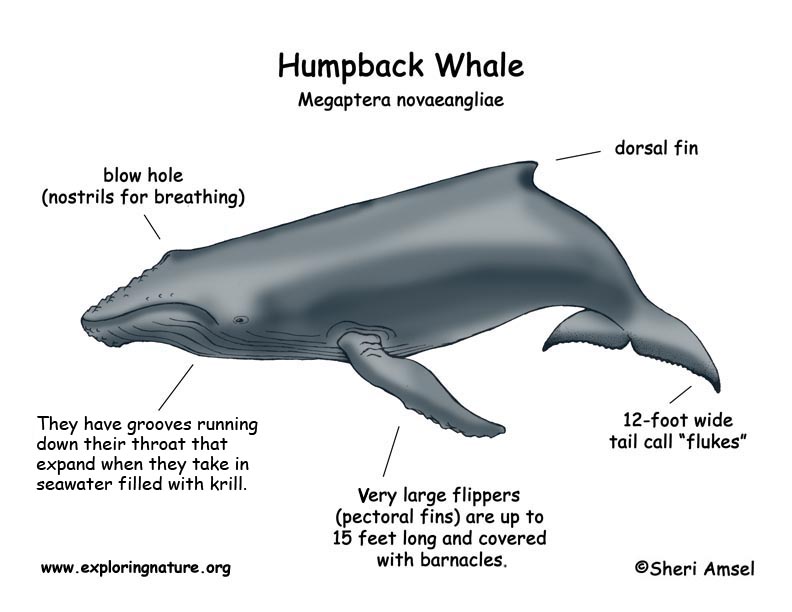

Humpback whales live in the North Pacific Ocean, the North Atlantic Ocean, and the Southern Hemisphere.
They migrate seasonally, mating and giving birth (calving) in tropical waters during the winter and then going to cold polar waters during the summer to feed.
They can grow to over 50 feet long and weigh 50 tons (100,000 pounds), the females are a bit larger than the males. They have very large front flippers (the largest of any whale), about 15 feet long and covered with barnacles. Their tail (called flukes) can be about 12 feet wide. Humpbacks often jump out of the water (breaching) or pop their heads out (spying) to look around. Male humpbacks have strange and beautiful songs that they sing. Gray to black in color, humpbacks have a series of grooves running down their throats that expand when they gulp in seawater filled with food.
They travel in small groups called pods swimming at 3-9 mph. They can migrate over 3,000 miles. They can dive over 700 feet deep and stay under water for more than 15 minutes, but in general humpbacks live on the surface of the ocean.
Like blue whales, humpbacks are baleen whales and have no teeth, just baleen plates. They push their giant tongues against the plates and squeeze out the water leaving in the krill (tiny shrimp-like animals), fish and plankton, to eat. They can eat more than 5,000 pounds of food a day.
Their only real predator is man.
Females are pregnant for 11-12 months (gestation) and have 1 calf. Calves drink 100 pounds of milk a day.
Humpback whales can live 45-50 years. They are listed as vulnerable on the CITES List (International List) and endangered on the U.S. Federal Endangered Species List.
Kingdom: Animalia
Phylum: Chordata
Subphylum: Vertebrata
Class: Mammalia
Order: Cetacea
Suborder: Mysticeti
Family: Balaenopteridae
Genus: Megaptera
Species: Megaptera novaeangliae
When you research information you must cite the reference. Citing for websites is different from citing from books, magazines and periodicals. The style of citing shown here is from the MLA Style Citations (Modern Language Association).
When citing a WEBSITE the general format is as follows.
Author Last Name, First Name(s). "Title: Subtitle of Part of Web Page, if appropriate." Title: Subtitle: Section of Page if appropriate. Sponsoring/Publishing Agency, If Given. Additional significant descriptive information. Date of Electronic Publication or other Date, such as Last Updated. Day Month Year of access < URL >.
Amsel, Sheri. "Whale (Humpback)" Exploring Nature Educational Resource ©2005-2024. December 14, 2024
< http://www.exploringnature.org/db/view/Whale-Humpback >

